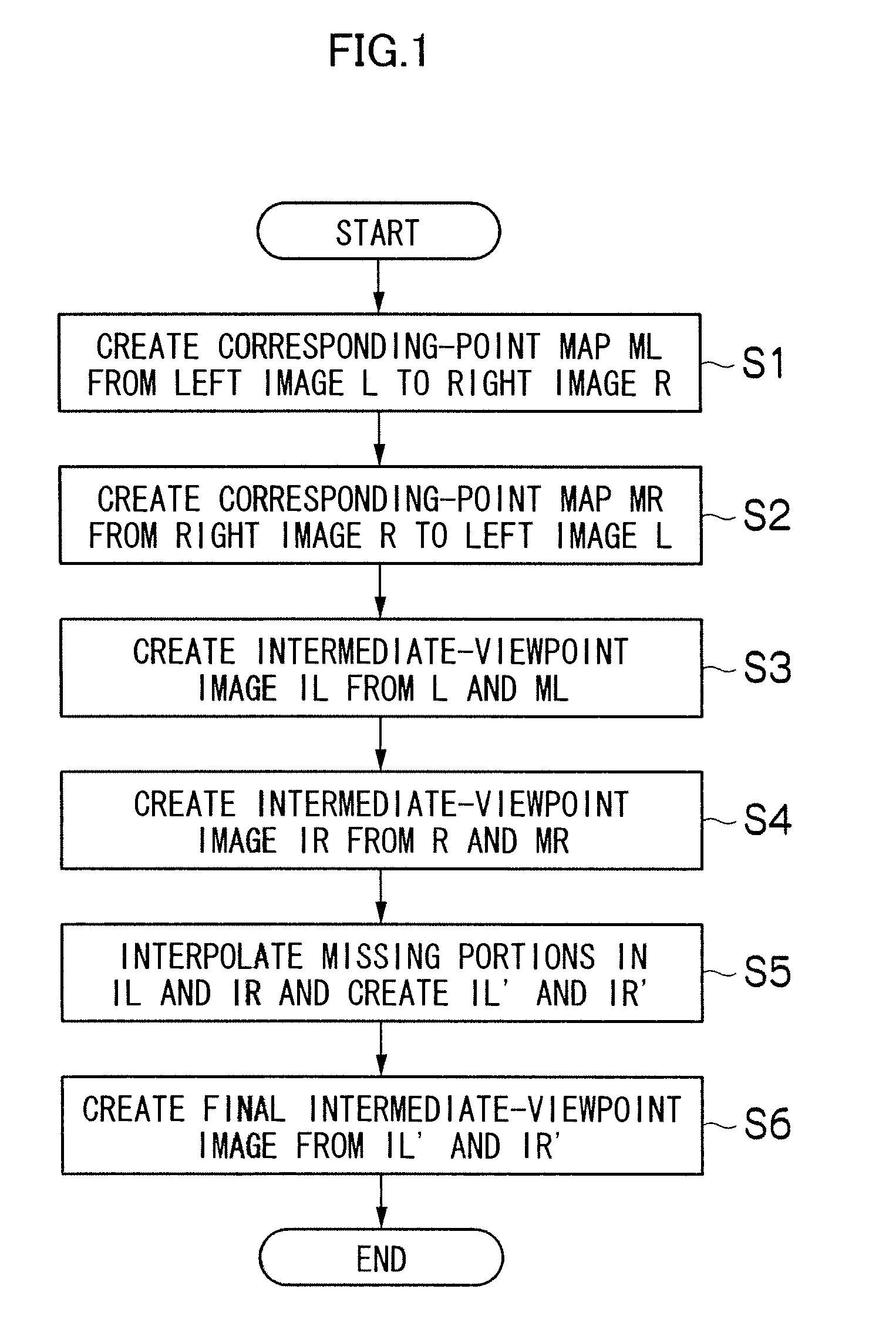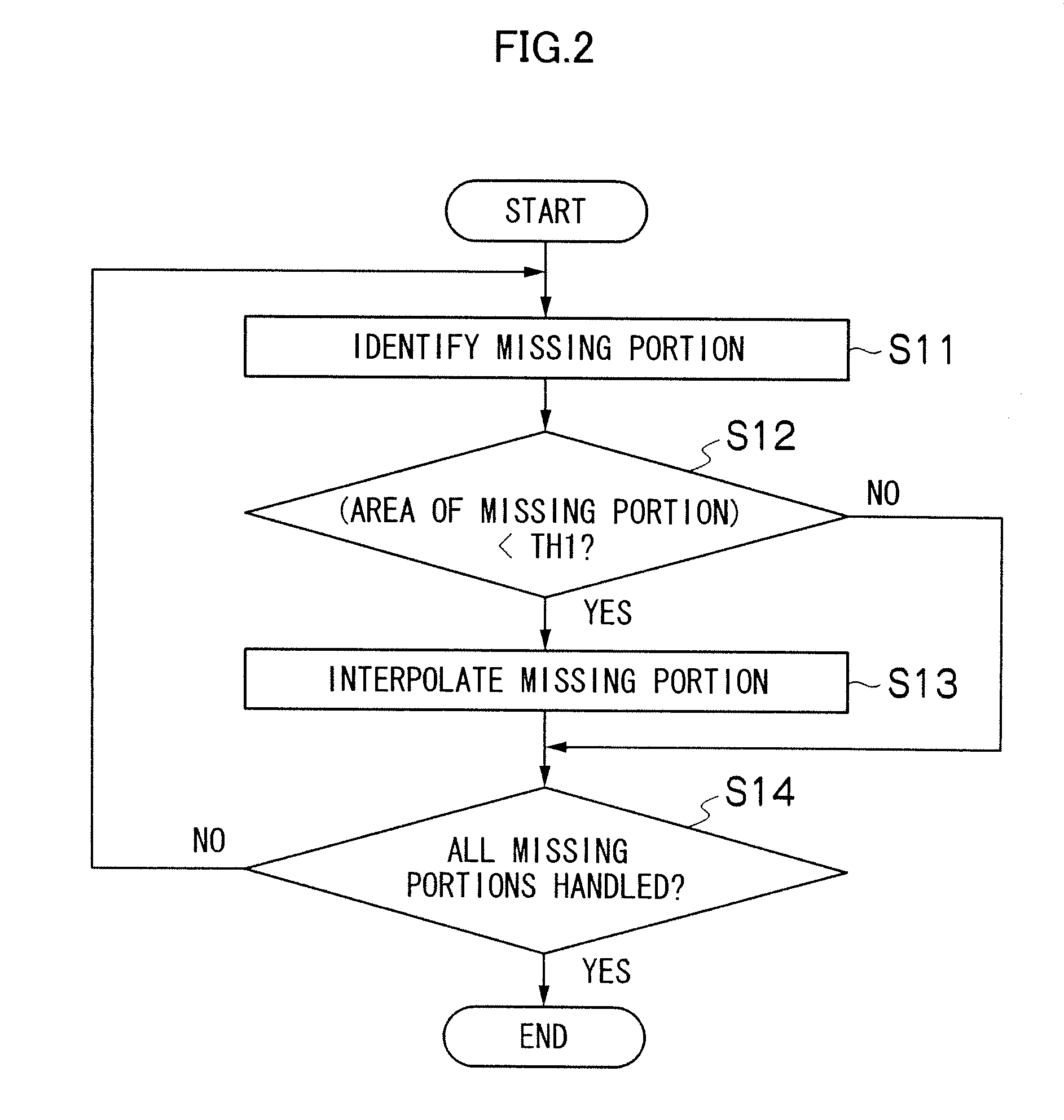Image processing apparatus, method, and recording medium
a technology of image processing and recording medium, applied in the field of image processing apparatus, a method, and a recording medium, can solve the problems of high computation load, and achieve the effect of reducing color unevenness
- Summary
- Abstract
- Description
- Claims
- Application Information
AI Technical Summary
Benefits of technology
Problems solved by technology
Method used
Image
Examples
first embodiment
[0049]FIG. 2 is a flowchart illustrating a process of interpolating missing portions according to a first embodiment.
[0050]First, a missing portion is identified in the intermediate-viewpoint image IL which is based on the left image L (step S11). A missing portion refers to a portion or region in which a pixel corresponding to a reference image is not laid within an intermediate-viewpoint image due to difference in the amount of movement between neighboring pixels during forward mapping for creating an intermediate-viewpoint image, like region Z illustrated in FIG. 9.
[0051]Then, the area of the missing portion identified is calculated, and it is determined whether the area is smaller than a threshold TH1 or not (step S12). Although the region Z in FIG. 9 is illustrated as being only one pixel in size in the vertical direction of the intermediate-viewpoint image IL, an actual missing portion can be present spreading in the vertical direction. In this way, the area of a missing porti...
second embodiment
[0060]FIG. 3 is a flowchart illustrating a process of interpolating missing portions according to a second embodiment. Steps common to the flowchart of FIG. 2 are given the same reference numerals and their detailed descriptions are omitted.
[0061]As in the first embodiment, a missing portion is identified in the intermediate-viewpoint image IL which is based on the left image L (step S11).
[0062]Then, a region corresponding to the missing portion identified at step S11 (i.e., a region at the same coordinate position as the missing portion) is extracted from the intermediate-viewpoint image IR which is based on the right image R, and a pixel variance value is calculated from the pixel values (luminance values) of pixels in the region (step S21). The pixel variance value may also be derived from the right image R, in which case a region in the right image R corresponding to the missing portion is identified and extracted through coordinate transformation.
[0063]Determination is made as ...
third embodiment
[0080]FIG. 6 is a flowchart illustrating a process of interpolating a missing portion according to a third embodiment. According to the third embodiment, the area and a variance value of a missing portion are determined before interpolation of the missing portion.
[0081]As in the previous embodiments, a missing portion is identified in the intermediate-viewpoint image IL which is based on the left image L (step S11).
[0082]Then, the area of the missing portion is calculated and it is determined whether the area is smaller than the threshold value TH1 (step S12).
[0083]If the area of the missing portion is equal to or larger than the threshold value TH1, it is determined that an error associated with interpolation is likely to occur, and the flow proceeds to step S14 without performing interpolation.
[0084]If the area of the missing portion is smaller than the threshold value TH1, a region corresponding to the missing portion identified at step S11 is extracted from the intermediate-view...
PUM
 Login to View More
Login to View More Abstract
Description
Claims
Application Information
 Login to View More
Login to View More - R&D
- Intellectual Property
- Life Sciences
- Materials
- Tech Scout
- Unparalleled Data Quality
- Higher Quality Content
- 60% Fewer Hallucinations
Browse by: Latest US Patents, China's latest patents, Technical Efficacy Thesaurus, Application Domain, Technology Topic, Popular Technical Reports.
© 2025 PatSnap. All rights reserved.Legal|Privacy policy|Modern Slavery Act Transparency Statement|Sitemap|About US| Contact US: help@patsnap.com



